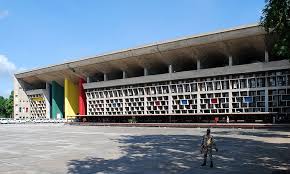Chandigarh: A Masterpiece of Modern Architecture by Le Corbusier
Chandigarh, often referred to as "The City Beautiful," is a city that stands as a testament to modern architecture and urban planning. Situated at the foothills of the Shivalik Range in northern India, Chandigarh is unique not only because of its design but also due to the vision that shaped it. This city was the first planned city in post-independence India and was designed by the world-renowned Swiss-French architect **Le Corbusier**, who took over from the original American planner, Albert Mayer.
The Vision Behind Chandigarh
Post-partition, India needed a new capital for the state of Punjab, as Lahore became part of Pakistan. The government envisioned Chandigarh as a symbol of progress, a modern city reflecting the aspirations of a newly independent nation. With the guidance of Prime Minister Jawaharlal Nehru, Chandigarh was conceived not just as a place to live, but as an embodiment of India's growth, embracing contemporary design principles while respecting functionality and human needs.
Nehru famously said, “Let this be a new town, symbolic of the freedom of India, unfettered by the traditions of the past. An expression of the nation's faith in the future.”
Le Corbusier’s Architectural Philosophy
Le Corbusier approached Chandigarh with a philosophy grounded in modernism. His design principles were based on functionality, simplicity, and open spaces. Le Corbusier was a pioneer of the International Style , characterized by clean lines, minimalism, and a rejection of excessive ornamentation. In Chandigarh, his vision came to life, creating a city that balanced concrete with nature.
The city plan was designed with the concept of human activity and human scale at its core. It was divided into sectors , each with its own essential services, like schools, hospitals, markets, and recreational spaces, making life efficient and organized. The sectors, often called “neighborhood units,” were self-sufficient, but all interconnected.
Iconic Architectural Landmarks in Chandigarh
Chandigarh is home to some of Le Corbusier’s finest creations, with buildings that have become iconic symbols of modern Indian architecture. Let’s explore a few of them:
1. The Capitol Complex
The Capitol Complex is the heart of Chandigarh’s government and its architectural grandeur. This complex comprises three main buildings—the Secretariat, the High Court, and the Legislative Assembly. Together, they represent the three pillars of democracy.
.The Secretariat: This massive horizontal structure houses the administrative offices. Its linear form and use of exposed concrete exemplify Corbusier’s preference for raw, natural materials.
.The High Court: With its bold, open façade and cantilevered roof, the High Court stands as a striking piece of architecture. The interplay of light and shadow on its massive, concrete structure is a characteristic of Le Corbusier's designs.
.The Legislative Assembly: Perhaps the most iconic of the three, the Legislative Assembly features a unique pyramid-shaped roof. It’s a powerful, sculptural piece that immediately catches the eye and symbolizes the democratic process.
In 2016, the Capitol Complex was recognized as a UNESCO World Heritage Site, further solidifying its global architectural significance.
2. Open Hand Monument
A symbol of peace and reconciliation, the Open Hand Monument is one of Le Corbusier’s most famous works in Chandigarh. The large, metal structure stands tall with a rotating hand, signifying the message of “open to give, open to receive.” This sculpture reflects Corbusier’s philosophy that architecture should serve as a symbol of deeper human values, transcending mere functionality.
3. The Chandigarh College of Architecture
Another notable structure is the Chandigarh College of Architecture, designed with the same principles of form, function, and balance. It stands as a center of architectural education, drawing inspiration from the city around it.
The Legacy of Chandigarh’s Architecture
Chandigarh’s urban design and architecture have inspired generations of architects and city planners. The city’s wide streets, ample green spaces, and the relationship between buildings and their environment are considered exemplary even today. Le Corbusier’s work in Chandigarh is often cited as a model for balancing urbanization with nature.
What makes Chandigarh so special is that, despite being an ambitious, large-scale project, the city never loses its human touch. The clean lines, the spaciousness, and the interconnection of sectors with ample green belts reflect a harmonious relationship between man, machine, and nature.
Chandigarh Today
Chandigarh continues to be admired for its design, but it’s more than just a museum piece. It is a living, breathing city, home to over a million people who enjoy its lush green parks, orderly streets, and architecturally significant buildings.
However, the city faces challenges. Rapid urbanization and population growth have put pressure on the infrastructure. But as the city adapts to these new realities, the original vision of Le Corbusier remains intact, reminding all who visit of its role as a pioneering work of modern architecture.
Conclusion
Chandigarh is not just an architectural marvel but a symbol of India’s vision for the future during its formative years. Through the genius of Le Corbusier, the city exemplifies the principles of modernism while addressing the real needs of its inhabitants. Today, Chandigarh stands as a globally recognized testament to thoughtful urban planning and timeless architectural design, a city that continues to inspire and evolve.















0 Comments